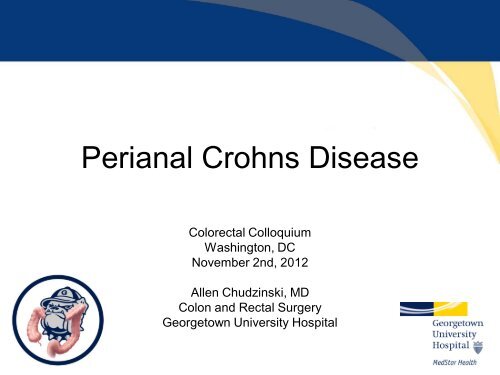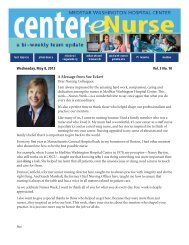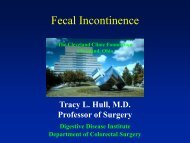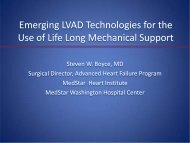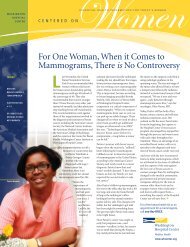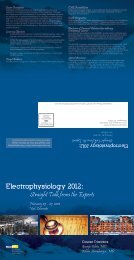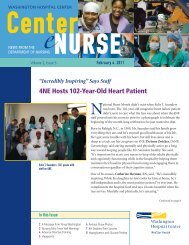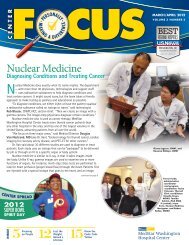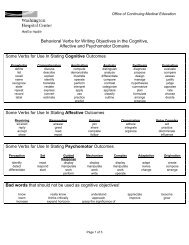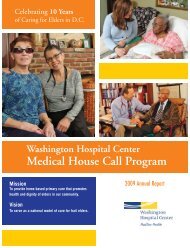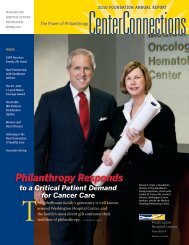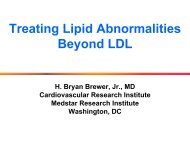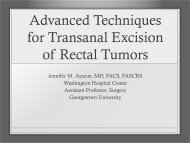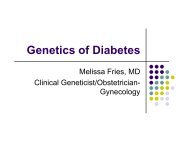Perianal Crohn's Disease - Washington Hospital Center
Perianal Crohn's Disease - Washington Hospital Center
Perianal Crohn's Disease - Washington Hospital Center
You also want an ePaper? Increase the reach of your titles
YUMPU automatically turns print PDFs into web optimized ePapers that Google loves.
<strong>Perianal</strong> Crohns <strong>Disease</strong><br />
Colorectal Colloquium<br />
<strong>Washington</strong>, DC<br />
November 2nd, 2012<br />
Allen Chudzinski, MD<br />
Colon and Rectal Surgery<br />
Georgetown University <strong>Hospital</strong>
<strong>Perianal</strong> Crohns<br />
• Often first sign of Crohns<br />
• Can precede intestinal symptoms by years<br />
• Pts with LB disease more likely to have<br />
perianal disease, compared to SB
• Fistula in ano<br />
<strong>Perianal</strong> <strong>Disease</strong><br />
• Rectovaginal Fistula<br />
• Fissure<br />
• Skin Tags<br />
• Hemorrhoids<br />
• Abscess<br />
• Anal Stenosis
• Multiple fistulas<br />
Signs<br />
• Lateral anal fissures<br />
• Large skin tags<br />
• Multiple lesions<br />
• Ulcerations<br />
• Anal stricture
<strong>Perianal</strong> Crohns
Workup<br />
• Colonoscopy, flexible sigmoidoscopy<br />
• ERUS<br />
• MRI<br />
• Exam under Anesthesia<br />
– Drain sepsis<br />
– Obtain biopsy
• Treatment options<br />
• Diversion?<br />
• Fistulotomy<br />
• Seton<br />
• I/D<br />
<strong>Perianal</strong> Crohn’s
Skin tags
Skin Tags<br />
• Most common finding in perianal Crohns<br />
• Edematous, thickened, large<br />
• Difficulty with cleansing<br />
• Can be painful
• Expectant<br />
• Sitz baths<br />
Skin Tag Treatment<br />
• Moist wipes for cleansing<br />
• Not advisable to resect<br />
• Exceptions in extreme circumstances
Abscess
<strong>Perianal</strong> Abscess
Abscess<br />
• 3 rd most common presentation<br />
• 70% associated with fistula-in-ano<br />
• Painful<br />
• Can become septic
Abscess Treatment
Abscess Treatment<br />
• Incision and Drainage<br />
• Office vs. OR<br />
• ID should be close to anal opening<br />
• Expectant fistula-in-ano<br />
• Fistula may already present
Abscess Fistula
Fistula in Ano<br />
• Second most common manifestation in<br />
perianal Crohns<br />
• Often one of the most challenging<br />
• Often complex fistulas
FISTULA
Fistula
Surgical Treatment<br />
• Depends on the severity<br />
• Active rectal disease?<br />
• Combined use of Biologics
Surgical Treatment<br />
• No active rectal disease?<br />
• Fistulotomy<br />
• Seton<br />
• Rectal Advancement flap
Complex Fistula
Surgical Treatment<br />
• Active Rectal <strong>Disease</strong> present<br />
• Seton/Fistulotomy<br />
• Biologic study on fistula closure<br />
• Diverting ostomy, +/- flap closure
Complex perianal Crohns
Anal Fissure
Fissure-nonCrohns<br />
• Split in anoderm in<br />
typically posterior<br />
midline<br />
• Often reported after<br />
hard bowel movement<br />
• scant amount bright<br />
red blood with pain
Anal Fissure Physiology<br />
• High resting pressure of the internal<br />
sphincter muscle<br />
• No differences in the maximum voluntary<br />
contraction ( external sphincter)
Anal Fissure<br />
• Reported to occur 20-35% of Crohns pts<br />
• Fairly common<br />
• Posterior(40%), Lateral(20%),<br />
Multiple(30%)<br />
• Pain mild compared to Non-Crohns
Anal Fissure<br />
• Nonoperative Treatment<br />
• Control proctitis ( Canasa)<br />
• Sometimes Ca+ Channel blockers and<br />
Lidocaine effective<br />
• If extreme pain EUA recommended<br />
• Extreme cases LIS
Lateral Internal Sphincterotomy
Rectovaginal Fistula
Rectovaginal fistula<br />
• In true <strong>Perianal</strong> Crohns disease can be<br />
devastating<br />
• Advancement Flap<br />
• Multilayer closure<br />
• Diversion<br />
• Gracilis muscle flap
RVF repair
RVF<br />
• Severe rectal disease present<br />
• Proctectomy
Hemorrhoids
Hemorrhoids<br />
Function<br />
Venous Plexus, sinusoids<br />
• Vascular structure whose walls do not<br />
contain muscle, thus sinusoids not veins<br />
• three main cushions: left lateral, right<br />
anteriorlateral, right posterolateral
Hemorrhoids<br />
Increased size in certain conditions<br />
Symptoms<br />
– Painless<br />
– Bleeding<br />
– Itching<br />
– Burning
Internal
External
Hemorrhoids<br />
• All attempts should be made at<br />
conservative therapy<br />
• Avoid surgery<br />
• Poor wound healing<br />
• Risk of fistula<br />
• Offered in extreme circumstances
External<br />
• Covered by anoderm: modified squamous<br />
epithelium w/o appendages<br />
• Innervated by somatic nerves – pain
External Hemorrhoids<br />
• Venous Congestion<br />
• SKIN<br />
• Thrombosed- Painful<br />
• Medical Treatment<br />
• Excision vs Thrombectomy<br />
• Significantly decrease in pain after 48-72h
Stenosis
• Spasmodic<br />
Anal Stenosis<br />
– Smooth Muscle Contraction<br />
• Fibrotic<br />
– Infectious, tissue destruction<br />
• Can be debilitating for patient
• Dilation<br />
• Bulk forming agents<br />
• Finger dilation<br />
• Operative dilation<br />
• Selected cases, LIS<br />
Anal Stenosis<br />
• Extreme-Proctectomy
Cancer<br />
• Always aware Crohns pts at increased risk<br />
• Colonoscopy<br />
• EUA<br />
• Biopsy


